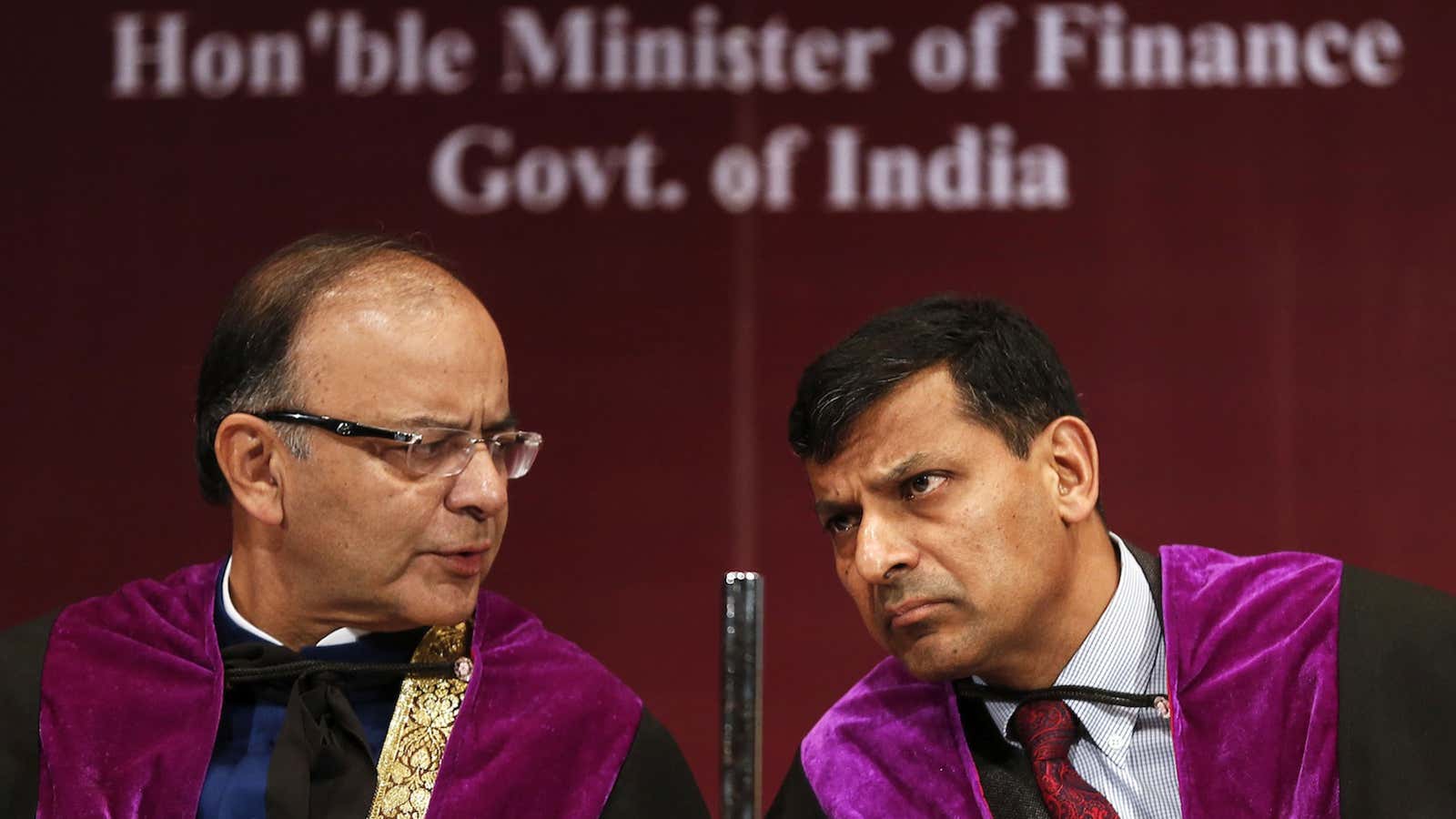The power struggle between India’s central bank and the Narendra Modi government is intensifying.
At the heart of the conflict is a new proposal by the Financial Sector Legislative Reforms Commission—first set up by the previous United Progressive Alliance government in 2011—that seeks to dilute the Reserve Bank of India’s (RBI) control over the country’s monetary policy.
Last week, a draft proposal from the commission suggested the formation of a monetary policy committee (MPC), where four out of the seven members will be appointed by the government. The draft also proposes taking away the veto power from the RBI governor.
If accepted, any decision about the monetary policy in the country—essentially, controlling interest rates and, consequently, inflation—will no longer be at the sole discretion of the RBI governor.
A former top RBI official described the proposal to remove the central bank governor’s veto power as “absolutely ridiculous.”
“The autonomy of a central bank is desirable,” he told Quartz, requesting anonymity. “In this case, from the national point of view, the proposals are completely injurious. It is not in the country’s interest.”
India’s minister of state for finance, Jayant Sinha, however, argued that the proposals are just recommendations. Sinha added that the government will ensure the RBI has full autonomy in framing monetary policy decisions. In his budget speech (pdf) in February this year, finance minister Arun Jaitley had said the Modi government would move to amend the RBI Act and set up the MPC.
“Logically speaking, the governor of the RBI, if made accountable for inflation targeting, should have all the powers to implement the necessary policy,” Charan Singh, the RBI chair professor at the Indian Institute of Management, Bangalore, told Quartz.
“This also implies that accountability and responsibility can only be imposed if the governor has the veto power and pursues the policy that he deems appropriate to achieve the target assigned to him by the ministry of finance,” he explained.
Growth vs. inflation
But tension between the Modi government and the RBI has been brewing for some time now.
On one hand, the government has been rooting for a relaxed monetary policy with lower interest rates, which in turn would increase consumer spending and drive inflation higher. RBI governor Raghuram Rajan, on the other hand, has a more hawkish stance—through maintaining higher interest rates—to keep inflation in check.
“The basic question here is about priorities. The government’s priority is growth while the RBI’s is to maintain inflation,” D. H. Pai Panandiker, an economist and president of the Mumbai-based RPG Foundation, which houses a macroeconomic policy think-tank, told Quartz.
Although the RBI has delivered on reining in inflation—it has brought down consumer price inflation from 6.77% in June 2014 to 5.4% in June 2015—the government wants it to do more to push for growth, even as the central bank’s governor has been loath to cut rates. By forming an MPC and appointing the majority of its members, the government can effectively call the shots.
“There is a perception that the government is more in favour of growth while the RBI wants to maintain inflation. So in case the revisions to the MPC are accepted, and if the members nominated by the government vote as a block, any policy outcome could be focused on growth rather than inflation,” Abheek Barua, chief economist at HDFC Bank, told Quartz.
That’s a view that other economists also share.
“With the RBI governor’s veto power taken off, and with more government-nominated members in the MPC, the members from outside the central bank can toe the government’s line,” said Devendra Kumar Pant, chief economist at credit rating agency India Ratings & Research, a unit of Fitch Ratings.
Members of the MPC
For some time now, the exact constitution of the MPC has been under debate.
In 2013, the initial proposal by the Financial Sector Legislative Reforms Commission had recommended that the MPC would have two RBI officials, two members recommended by the central bank governor, and three that would be selected by the government.
Then, in January 2014, the Urjit Patel committee—tasked by the RBI to suggest reforms in the monetary policy framework—recommended that the MPC have no government representation, and that there should be two external members who are experts in finance and policy.
The latest proposal recommends an MPC consisting of the RBI governor, an executive member of the RBI, an RBI employee nominated by the governor and four members nominated by the central government.
“I think the panel which has been proposed with a government majority is an absolutely wrong thing,” RPG Foundation’s Panandiker argued. “Although I do feel leaving the decision about the monetary policy to one person is also not right, the panel should constitute top bankers rather than government representatives.”
Meanwhile, economists Surjit Bhalla and Arvind Virmani—who is also a former chief economic advisor—suggested that the MPC must be formed with external members who do not belong to either the RBI or the government. The economists also suggested the model adopted by Israel which constitutes six members, including the central bank governor, and has three members selected by the government.
“Regardless of which of our proposed structures is adopted, we want to emphasise that it is important that the RBI have both the responsibility and accountability for monetary policy,” they wrote in the Indian Express.
“It should also be, and seen to be, independent of the government of India.”
We welcome your comments at ideas.india@qz.com.
